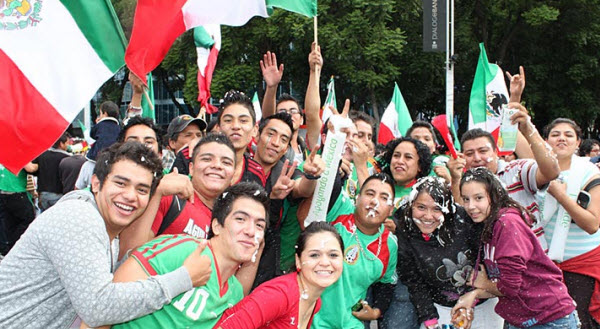Mexico is a country located in North America, bordering the United States to the north and Central America to the south. It is one of the largest nations in the region, with a rich cultural and historical heritage.
Geography

Location: North America
Coordinates: Approximately 23.6345° N, 102.5528° W
Area: About 1,964,375 square kilometers.
Borders:
- North: United States (3,145 kilometers)
- South: Guatemala and Belize (963 kilometers)
- East: Gulf of Mexico and the Caribbean Sea
- West: Pacific Ocean
Climate:
Varies from desert in the north to tropical in the south, with temperate climates in mountainous and coastal areas. The central region enjoys a moderate climate.
Topography:
Mexico has diverse topography with mountains, coastal plains, plateaus, and deserts. Major mountain ranges include the Sierra Madre Occidental, Sierra Madre Oriental, and Sierra Madre del Sur.
Elevation:
The highest peak is Pico de Orizaba (Citlaltépetl), with an elevation of 5,636 meters.
Natural Resources:
Mexico is rich in natural resources such as oil, natural gas, silver, gold, copper, coal, and industrial minerals.
Land Use:
- 54% agriculture
- 33% forests
- 13% urbanized and other uses
Population Distribution:
Population density is higher in metropolitan areas like Mexico City, Guadalajara, and Monterrey, while it is lower in rural regions.
Population and Society

Population: Approximately 128 million (2024 estimate).
Ethnic Groups:
The majority of the population is mestizo (around 62%), with indigenous groups (around 21%) and people of European descent (around 10%).
Languages:
The official language is Spanish. Over 60 indigenous languages are spoken, including Nahuatl and Maya.
Religions:
Christianity, primarily Roman Catholicism (around 78%), is the dominant religion, with a growing number of evangelicals and other religious minorities.
Age Structure:
Mexico has a young population, although the aging rate is increasing. The median age is approximately 29 years.
Population Growth Rate:
Around 1.1% annually.
Country

Official Name: United Mexican States
Common Name: Mexico
Reason for Name: Derived from the Nahuatl word “Mēxihco,” which was the name of the heart of the Aztec Empire.
Type of Government: Federal Representative Republic.
Capital: Mexico City (CDMX)
Reason for Naming Capital: Simply named “Mexico,” reflecting its historical and political centrality.
Local Time: Mexico has several time zones: Pacific, Central, and Southeastern.
Daylight Saving Time: Observed in most parts of the country, with exceptions in states bordering the United States.
Administrative Divisions: 32 federal entities, consisting of 31 states and Mexico City as a special entity.
Territories: Mexico does not have any overseas territories.
Independence: Gained from Spain on September 16, 1810.
Citizenship Acquisition: By birth in Mexico, descent from Mexican citizens, or naturalization.
Legal System: Civil law system based on the Constitution of 1917.
Executive Branch: The president is both head of state and government.
Legislative Branch: Congress of the Union, composed of the Chamber of Deputies and the Senate.
Judicial Branch: Includes the Supreme Court of Justice of the Nation and other federal courts.
Political Parties: Includes the National Regeneration Movement (MORENA), National Action Party (PAN), Institutional Revolutionary Party (PRI), among others.
Flag Description: The Mexican flag features three vertical stripes of green, white, and red, with the national coat of arms in the center of the white stripe.
Country Code: MEX
Economy
GDP: Approximately $1.3 trillion USD.
Agricultural and Animal Products: Corn, beans, coffee, avocados, livestock, and seafood.
Industries: Mexico has a strong manufacturing industry, notably in automobile production, electronics, processed foods, and oil.
Budget: Mexico maintains a budget deficit but is working to stabilize its economy.
Exports: Vehicles, oil, electronics, machinery, and food products.
Imports: Machinery, electrical equipment, chemicals, consumer goods, and fuel.
Foreign Reserves: Approximately $200 billion USD.
External Debt: About $470 billion USD.
Local Currency: Mexican Peso (MXN).
Communications
Landlines: About 20 million lines.
Mobile Lines: About 127 million lines.
Country Code: +52
Broadcast Media: Mexico has a wide range of national and regional television and radio stations, both public and private.
Internet Code: .mx
Internet Users: Approximately 90 million people.
Transportation

National Air Transport System: Mexico has a well-developed air transport network, with international airports in Mexico City, Cancún, Guadalajara, and Monterrey.
Airports: Over 1,800 airports, including commercial and private flights.
Helipads: Major cities have helipads.
Pipelines: Extensive pipeline network for transporting oil and gas.
Railroads: Mexico has a rail network of over 20,000 kilometers, primarily for freight transport.
Road Network: More than 370,000 kilometers of roads, including modern highways.
Ports: Major ports include Veracruz, Manzanillo, and Lázaro Cárdenas.
Military

Military Composition: The Mexican Armed Forces include the Army, Navy, and Air Force.
Military Spending: Approximately $7 billion USD annually.
Military and Security Personnel: About 230,000 active-duty members.
Military Equipment: Includes fighter jets, warships, helicopters, and armored vehicles.
Military Service Age: Military service is compulsory for men starting at 18 years old.
